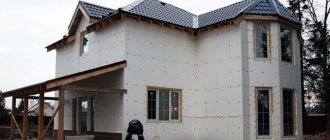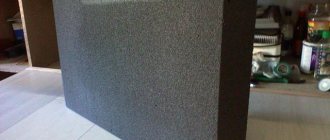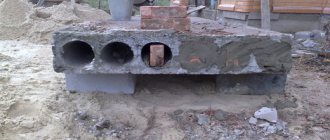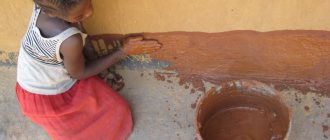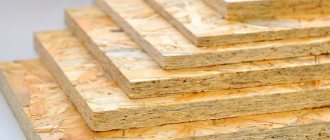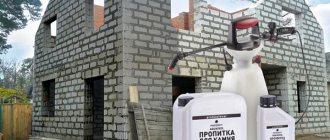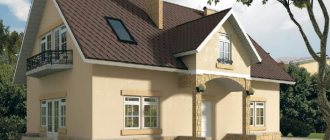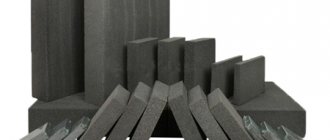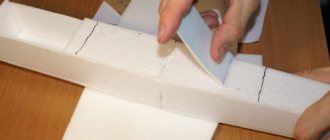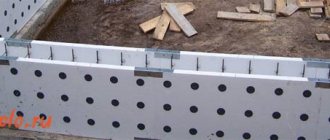The desire to combine completely different properties in one material is the driving force of modern construction science.
She made cold and heavy, but durable concrete light and warm by introducing into its structure a polymer foamed in the form of granular balls.
The new material is called polystyrene concrete. The first mention of it dates back to the middle of the last century, when the German chemical concern BASF developed the technology for its production.
Later, in the USSR, research was also carried out on the physical and mechanical properties of cement stone with polystyrene foam filler.
However, this material has not become widespread in housing construction, although in 1973 a special GOST R 51263–99 was developed for it.
Today, the production of polystyrene concrete is organized on an industrial scale and many developers choose it. In order to understand how beneficial the use of polystyrene concrete is in individual housing construction, it is necessary to study its properties in more detail.
Main characteristics
First, let's look at the physical and mechanical properties of polystyrene concrete, standardized by GOST:
- The density of the material ranges from 150 to 800 kg/m3;
- Frost resistance ranges from F35 to F300 (from 30 to 150 freeze-thaw cycles);
- Compressive strength ranges from B0.35 - B2.5 (grade M5 - M35);
- Thermal conductivity coefficient: minimum 0.055 W/mC, maximum 0.145 W/mC;
- Vapor permeability is 0.05 mg/(m h Pa);
- Flammability group G1 (non-flammable material).
At first glance, it seems that the “construction passport” of polystyrene foam is normal, and it is optimally suited for the construction of walls. However, some physical parameters are questionable. The compressive strength of this material is not high (maximum M35), so buildings with a height of more than 2 floors should not be built from it.
The low vapor permeability of polystyrene concrete has its pros and cons. Blocks made from it practically do not absorb water, so they resist temperature transitions well beyond 0 degrees. It is for this reason that the frost resistance of this material is very high. But a wall made of polystyrene foam will not breathe, because it is very difficult for water vapor to pass through it.
Environmental friendliness is another stumbling block that confuses those who would like to use expanded polystyrene concrete. We will not repeat the arguments of supporters and opponents of this material, but note for ourselves that the truth can only be established after many years of research. Only by using a sensitive gas analyzer to monitor the level of styrene in the air can a reasoned conclusion be made about the toxicity or safety of polystyrene foam blocks. Unfortunately, no one has made such observations.
Hygienic certificates issued by laboratories for blocks made of polystyrene foam confirm its environmental safety. Without a serious evidence base, we have no reason to argue with them.
Density is the main factor that determines the scope of application of this material. According to the accepted gradation of volumetric weight, concrete with the addition of polystyrene foam is no different from other types of building blocks.
The first group includes polystyrene concrete blocks with a volumetric weight of 150 to 300 kg/m3. They are used exclusively for external cladding of buildings and for laying internal non-load-bearing partitions.
The second group is structural and thermal insulation blocks with a density from 350 to 500 kg/m3. Used for laying internal load-bearing walls.
The third group is represented by polystyrene concrete with a density of more than 500 kg/m3. This material is called structural. It is suitable for the construction of external walls of low-rise buildings (up to 2 floors).
Advantages of foam blocks
Foam blocks make it possible to simply and inexpensively build houses with a different number of floors. The light weight of foam materials ensures fast and inexpensive transportation of workpieces to construction sites.
Foam building blocks have many advantages:
- lack of hygroscopicity;
- insulation from cold and noise;
- the ability to slowly pass air;
- resistance to rotting, fungal plaque;
- ease of processing and installation.
Modern blocks made of expanded polystyrene, the price of which is low, make it possible, due to the listed advantages, to increase the service life of the building’s load-bearing structures.
Briefly about production technology
Polystyrene concrete is a composite material consisting of beads-granules of foamed polymer and cement stone, forming a strong structural lattice. To improve the homogeneity of the material, air-entraining and surface-active chemical additives are used.
By adjusting the ratio of cement and water in the initial mixture (Table 1), it is possible to produce concrete of varying densities.
Table 1 Note* PVG – polystyrene granules
In addition to water and cement, some manufacturers use sand, adding it to the raw materials.
Table 2 (percentage composition of polystyrene concrete with the addition of sand)
Advantages and disadvantages
What is the advantage of polystyrene concrete as a building material, and how does it differ from its competitors - wood concrete, gas concrete and foam concrete?
The first plus is high energy-saving characteristics (there is no need for additional insulation). The second advantage is that the material does not require waterproofing.
The third advantage is plasticity (gas silicate and foam concrete blocks, on the contrary, are very fragile). This material is positively characterized by its high biological resistance (it does not mold or rot). It is also important that polystyrene concrete blocks have precise dimensional geometry. This simplifies the laying and allows you to significantly save mortar (joint thickness 3-5 mm).
The disadvantages include a fairly high cost and low durability (although manufacturers claim that a house made of polystyrene concrete has a service life of up to 100 years). They draw such conclusions only on the basis of the results of testing the frost resistance of this material, without delving into the specifics of the chemical properties of the polymer filler.
They can be countered with the following argument: any polymer material is subject to the process of aging and destruction. With foamed styrene, this process is much faster than with a solid (monolithic) polymer. Protecting cement stone cannot guarantee its durability. Indeed, the solution does a good job of protecting polystyrene foam from solar ultraviolet radiation, but cannot protect it from heat. Therefore, the aging process of insulation granules in the block does not stop. Not in 100 years, but much sooner, the polymer will completely collapse and turn into gas.
Reviews about this material are divided into two approximately equal groups: some developers praise polystyrene concrete for its excellent heat-saving properties. Others complain about large shrinkage of the masonry (1-2 mm per 1 meter of height) and problems with plastering (poor adhesion to the mortar).
There are often complaints about the loosening of window and door frames and the inability to securely fix them in the openings. Another negative point is the inability of polystyrene concrete walls to hold fasteners for shelves and cabinets.
Having comprehensively assessed the pros and cons of polystyrene concrete blocks, we can draw the following conclusion: the optimal area of application for them is not permanent residential buildings, but household and technical buildings.
Warm blocks for walls (heat block) - what is the problem of application
Three-layer wall blocks, consisting of two layers of concrete and insulation between them, are a relatively new building material. According to the plan, they should simplify, speed up and reduce the cost of building three-layer walls. But did everything work out?
There are no building codes or regulations for these blocks. There are only recommendations for their use developed by one of the institutes. Designers who do not depend on the companies that produce these blocks try not to include them in house designs.
Such blocks are not difficult to produce. They are produced by many small manufacturers. (... which often fail to fulfill the stated characteristics). But also a number of large ones. The well-known brands are Teploblok, Polyblok, Kremnegranit, Telosten..... But the essence is the same - a three-layer heat-efficient wall block, characterized by increased heat conservation.
Why do experts try to do without warm blocks?
Heat block design
The usual dimensions of warm blocks (thermally efficient wall blocks) are shown in the figure. With a total width of 300 - 400 mm, the thickness of the layers can be different. The inner concrete layer is the widest, 120 - 200 mm, and has the greatest impact on the strength of the wall.
The outer layer is narrower, finishing, can be painted, and equipped with a relief, textured surface.
The insulation is most often foamed polystyrene foam (EPS), and the more expensive extruded polystyrene foam XPS is also less common. The thickness of the insulation varies between 100 - 160 mm.
To connect the layers, plastic anchors are most often used in addition to glue. Or the strength of the connection of the layers is increased due to the comb shape of the connection, which prevents tensile forces.
What are they releasing?
Blocks from small manufacturers with metal internal reinforcement are more likely to fall into the “reject” category due to increased thermal conductivity and reduced durability.
All block configurations necessary for the construction of walls are produced.
When purchasing, you need to purchase all the configurations necessary for masonry, use the order of the project, durable concrete products are not easy to cut.
The composition of concrete can vary greatly; various heavy durable fillers and expanded clay are used. And some manufacturers use both mineral wool and foam glass as insulation.
Technical characteristics of warm blocks
The dimensional error in the manufacture of blocks is often no more than 2 mm. This allows you to lay blocks on a thin layer of glue - 3 - 5 mm. If the dimensional accuracy of the blocks is more than 2 mm, then the masonry is made using ordinary cement-sand mortar with a joint thickness of 10 mm.
An important characteristic of heat blocks is the resistance to heat transfer of the finished wall. First of all, it will depend on the thickness of the insulation layer. And also from his appearance.
Polystyrene foam is “colder” than extruded polystyrene foam. In addition, the foam can be moistened. At the same time, it significantly increases its thermal conductivity. While extruded polystyrene foam does not absorb water and does not change its thermal conductivity when the wall is saturated with moisture.
Heat transfer resistance
The table provides information about the heat transfer resistance of heat blocks depending on the insulation material, layer thickness, and humidity.
For blocks in the wall, the maximum humidity value should be taken.
Heat blocks, even with a small thickness of extruded polystyrene foam (XPS), have satisfactory heat transfer resistance for many regions according to SNiP.
Before choosing a heat block, you need to find out more precisely what heat transfer resistance should be at the walls of a house in a specific climate zone according to the standards.
The wall design itself practically does not increase thermal conductivity. The coefficient of thermal heterogeneity of a wall made of this material when laid on glue with thermal break of seams on foam plastic is 0.92. The thermal insulation characteristics of the wall will depend mainly on the correctness of the masonry; it is necessary to prevent cold bridges.
Strength of heat blocks and walls made from them
The strength characteristics of warm blocks are the most important. In a conventional three-layer wall, only the inner layer is the load-bearing layer. And the outer one creates façade finishing and protection for the insulation; it does not take the load from the overlying structures. How three-layer walls are insulated and finished
In a wall made of three-layer warm blocks (thermal block, polyblock, porcelain stoneware, thermal...) both the inner and outer layers are load-bearing.
Layer thickness in blocks
What thickness of concrete layers should be in a warm block to ensure the strength of the wall throughout its service life? It is known that experts recommend using heat blocks with an inner layer thickness of at least 180 mm for two- and three-story buildings.
For a one-story building with a non-residential attic, it is permissible to use blocks with an internal concrete layer thickness of 130 mm, but subject to mesh reinforcement of the masonry (every fourth layer), openings, as well as the creation of a reinforced concrete belt under the floors.
Compressive strength characterizes the entire block as a solid product - found in M35, M50, M75. When determining the characteristics, all layers are taken into account, even foam.
It is necessary to distinguish between the strength of the concrete from which the block is made and the strength of the block itself. The compressive strength of the concrete from which the block is made will be greater than the similar characteristic adopted for the entire block as a whole.
Increasing the width of the insulation leads to a thinning of the internal load-bearing layer of concrete. Ensuring strength, reliability and durability is the main criterion when choosing blocks. Therefore, it is impossible to reduce the thickness of concrete in pursuit of better heat conservation.
Features of application
The use of warm blocks is still experimental.
Research Institute "Teplosten", which are considered the developers of this technology, recommend using a spatial reinforced concrete building frame together with blocks. And the blocks themselves can have a total thickness of 300 mm (with reduced strength characteristics).
But the construction of a spatial reinforced concrete frame, although not so expensive, complicates the construction process; many construction organizations simply avoid such problems, preferring classic masonry.
Most manufacturers recommend using wider blocks. By making external and internal load-bearing connected walls from them, together with the ceiling, they form the load-bearing frame of the building (according to the project).
How to do masonry
When laying, it is recommended to fill the vertical and horizontal seams between the concrete parts with glue (mortar). (any masonry adhesive can be used, for example under tiles). And the seams between the foam parts are made with ordinary polyurethane foam. When using a solution, flexible tape insulation can be placed on the foam.
Some manufacturers produce blocks with holes in the thick inner layer specifically for creating vertical reinforcement with steel rods, and a spatial reinforced frame directly in the blocks.
Question with seams
A special feature of the use of heat blocks is the absence of external plaster and the jointing of through joints in the masonry. In this case, it becomes necessary to very carefully and reliably rub all the seams between the blocks from the outside. Why use the same masonry adhesive, and on top of it façade primers or silicone sealant.
It is necessary to monitor the condition of these seams throughout the operation of the building. When the wall is soaked with sediment, water can get inside the wall through small cracks in the seams. Which threatens it with frost destruction, loss of thermal and strength properties, penetration of moisture into the house, and destruction of the polyurethane foam in the seams.
Walls made of this material with a relief surface on the outside are additionally painted with facade paints with any vapor permeability, usually in light colors, which creates additional protection for the structure.
The technology of protecting the wall from the outside by grouting through joints between load-bearing elements seems unreliable.
Unlike aerated concrete or porous ceramics, which are also laid with through seams, but for which an external protective finish of the wall is always provided, façade plaster is lightweight
Durability
The presence of the synthetic substance polystyrene foam between the mineral load-bearing layers also raises questions. Expanded polystyrene has a service life that is not as long as mineral substances. Presumably this insulation will gradually decompose, compact, crumble, etc. And here this layer is a binder and can take loads...
After all, the predicted service life of polystyrene foam insulation and mineral wool on a wall is only 35 years, after which it is necessary to carry out the next energy audit of the building and replace insulation materials that have become unusable. Even clinker brick cladding in a three-layer wall can be disassembled brick by brick to replace the insulation. But in this case... The durability (100 years or more) of walls made of thermal blocks is in doubt.
Blocks made entirely of mineral substances, where the insulation is foam glass, “eternal” and vapor barrier, are clearly the preferred option. But they are much more expensive.
The use of mineral wool in blocks, which not only has a short service life, but also absorbs water like a sponge, also raises many questions.
According to the project
Heat blocks (three-layer concrete blocks with a middle layer of insulation) can only be used in accordance with a design made specifically for this wall material.
Based on the calculations, the optimal design of the heating block will be selected, as well as the reinforcement and spatial frame formed by the walls and ceilings.
You should not use the services of drawing up specifications and orders for heating blocks based on any house design offered by manufacturers of this material.
Advantages and disadvantages
The pros and cons of heat blocks, as well as how walls are laid from this material, can be found in this film
Types, sizes and approximate prices
Three standard sizes of blocks (width-height - length) are in greatest demand among developers: 300x380x588 mm, 188x300x588 mm (wall) and 92x300x588 mm (partition).
Some manufacturers make reinforced window and door lintels of different lengths (from 1.3 to 4.4 meters) from polystyrene concrete with a density of 600 kg/m3. They perform two functions at once: load-bearing and heat-insulating structures.
The average cost of 1 m3 of polystyrene concrete blocks is 3,500 rubles. For comparison, the average price of 1m3 of high-quality aerated concrete is 3800 rubles/m3. Foam concrete masonry blocks cost about the same - 3,500 rubles per 1 cubic meter.
Expanded polystyrene blocks with cladding
Arbolite (wood-cement blocks) are more expensive than polystyrene, their cost reaches 4,500 rubles/m3. However, they have higher strength, environmental friendliness and durability. To be fair, it should be said that in different regions of the Russian Federation the price for these building blocks may differ significantly.
Kinds
Polystyrene concrete blocks have undeniable advantages, as well as disadvantages. However, the dominance of the former over the latter explains the popularity of this type of building materials. Experts often choose them to build a house. Various types of products allow them to be used for finishing and other types of work.
- Polystyrene concrete blocks with cladding. They do not require additional façade finishing. The cladding is attached without glue; its layer is embedded in the concrete structure. The cladding imitates the appearance of stone, granite, and marble. Such blocks are resistant to any climatic conditions. With their help you can build a reliable house.
- Wall blocks. A house made of polystyrene concrete blocks will retain heat: the walls will not require additional insulation. In addition, plastic blocks are approximately two times cheaper than bricks. They are highly durable, easy to process, have high sound protection, and are fire resistant. In addition, the blocks perfectly withstand the negative effects of climatic conditions, acids and other substances, and harmful microorganisms.
Return to contents
